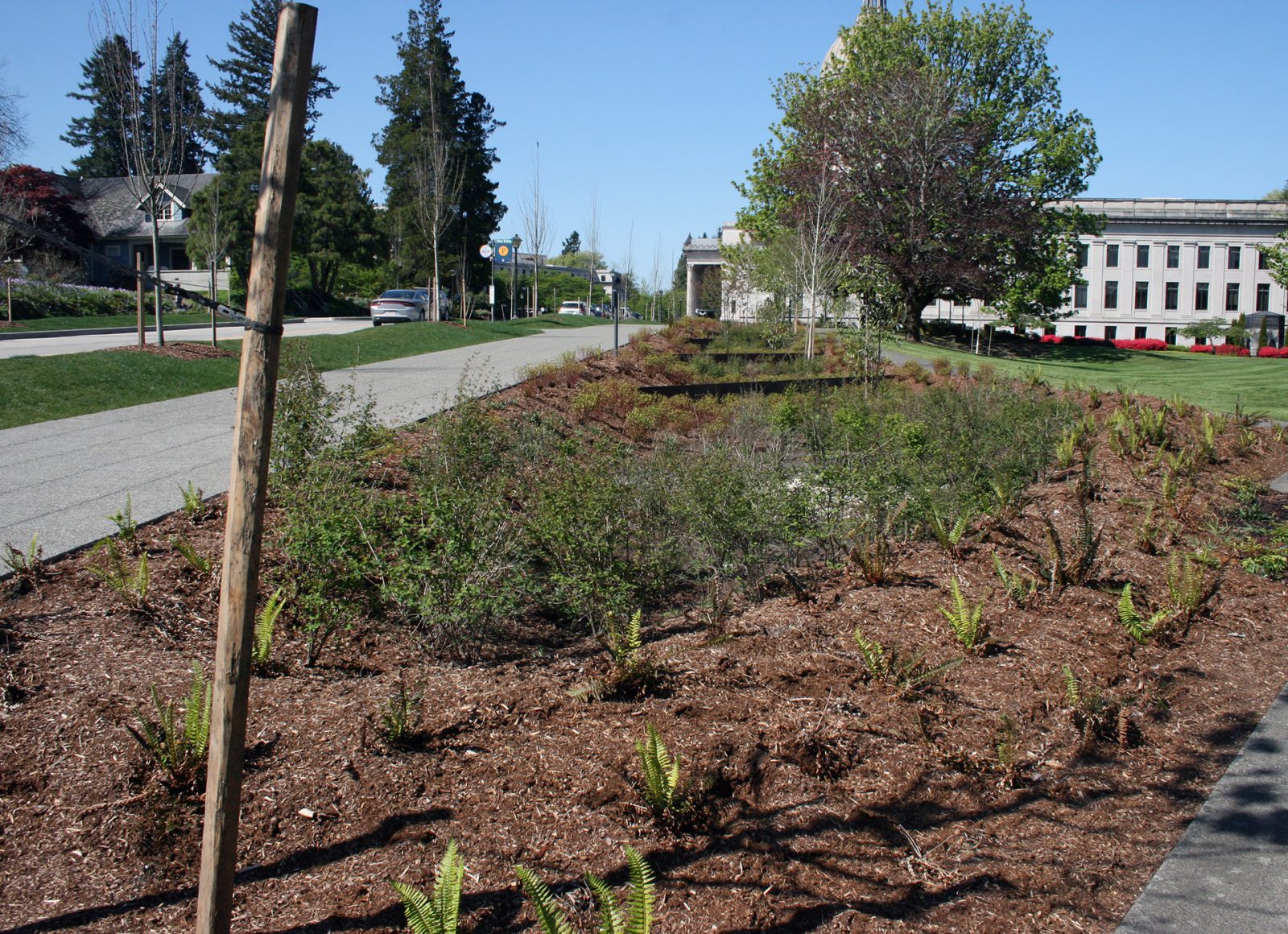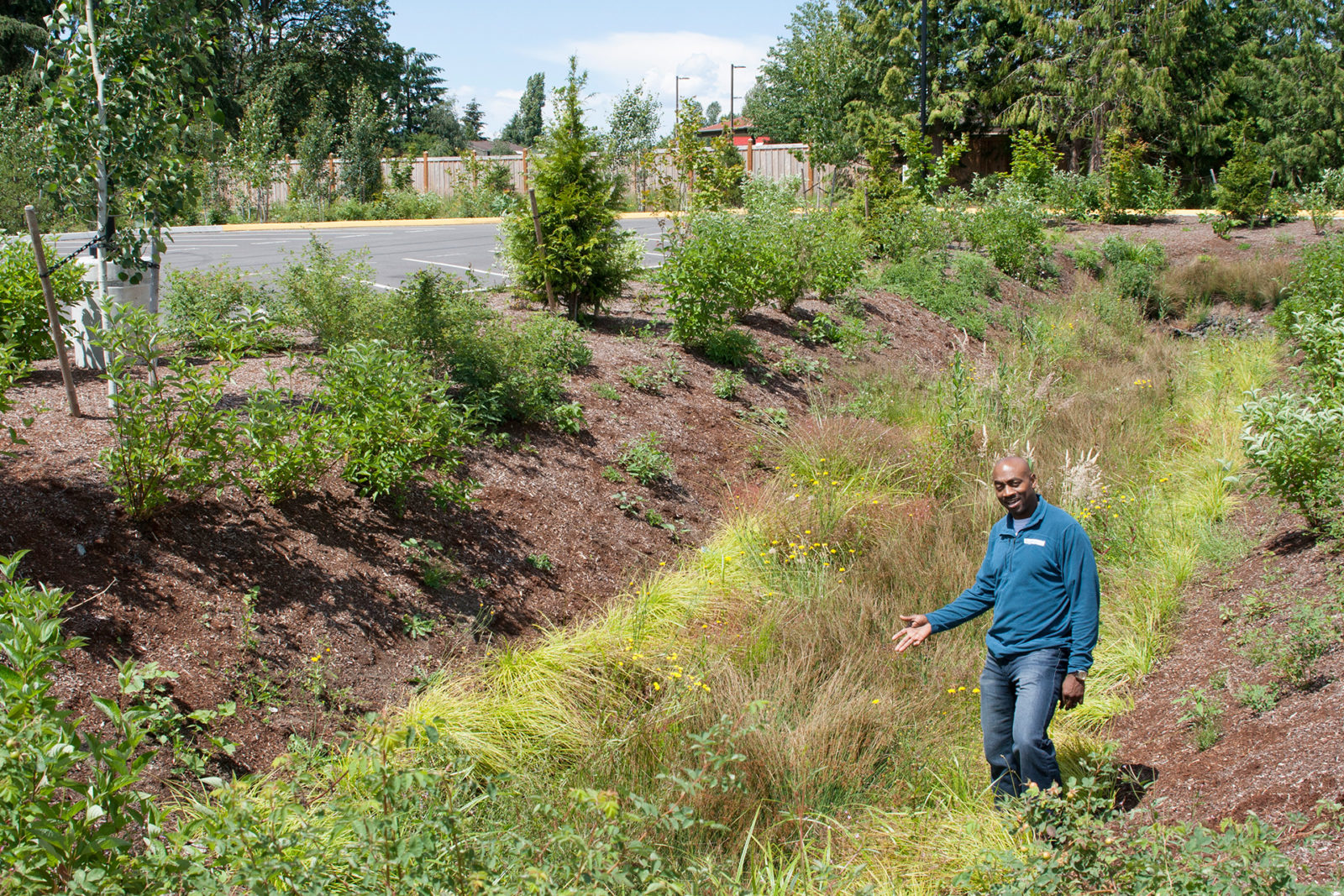
LID & Sustainable Design
Put a LID on it!
Low Impact Development (LID) is a stormwater and land use management strategy. The goal of LID is to mimic natural processes such as infiltration, filtration, storage, and evaporation by focusing on conservation and use of on-site natural features and stormwater management practices. Reid Middleton collaborates with clients and design teams to meet the goals of LID to prevent chemical and biological degredation to streams, lakes, and wetlands from development sites. Our team has extensive knowledge of the recommended strategies detailed in the Low Impact Design Manual to provide flow control, water quality, and wetland preservation on various development projects. We have used the following LID techniques on our projects:
- Bioretention Cells
- Rain Gardens
- Infiltration Trenches/Basins
- Full Dispersion via Trenches and Sheet Flow
- Basic Dispersion via Trenches and Sheet Flow
- Bio-swales
- Porous Pavements
GOING GREEN
Incorporating sustainable design features is a goal for every Reid Middleton project. We are skilled at designing sustainable solutions that can support University of Washington (UW) objectives and enhance the environment. An example of this was an early application of innovative sustainable design principles at Terrace Park School in Mountlake Terrace, Washington. Reid Middleton enhanced the environment by using an integrated design approach to the storm drainage system that combined shallow wet ponds; wetland and grass-lined, water quality treatment systems; and a pipe manifold detention facility underneath the parking lot. The site design reduced the net impervious surface area from more than five acres to 3.7. The remaining 1.3 acres were turned into meadows and open green space. These facilities have increased stormwater return to the groundwater system, reduced the impact of stormwater on nearby streams and conveyance facilities, and reduced the development footprint by being built under needed parking areas rather than separate at grade ponds or basins. The project was honored with the Gold Award for Social/Economic/Sustainable Design Considerations by the Washington chapter of the American Council of Engineering Companies (ACEC).
Use of the LEED™ System
The Reid Middleton team is well versed in the use of the U.S. Green Building Council LEED™ Building Rating System. The LEED™ Building Rating System is an excellent tool to ensure a balanced approach to sustainable design. We have been involved in many projects where the LEED™ rating system has been incorporated into the design. Unusual for a civil/structural engineering firm, Reid Middleton was the prime consultant for design of the MAB-3 facility for the US Navy. In this capacity, we utilized a life-cycle cost approach for facility design and led the LEED™ analysis for the project. The facility achieved a LEED™ Silver Certification. Civil design features include balancing earthwork on the site, provisions for car pools and bicycle storage, and on-site treatment, low-impact development of stormwater design. Structural features included close coordination with the architect to ensure building envelope insulation, incorporation of recyclable materials, and close coordination with the mechanical systems designer to accommodate energy efficient equipment. We have also been on teams that have been certified at LEED™ Silver and Gold levels on higher education dormitories, administration buildings and instructional facilities. Some examples of LEED™ certified buildings include:
- Bachelor Enlisted Quarters at Naval Station Kitsap-Bangor, Bremerton, WA (LEED™ Gold)
- Salish Hall at Green River Community College, Auburn, WA (LEED™ Silver)
- Echo Glen Juvenile Detention Facility Cottage Renovation, King County, WA (LEED™ Silver)
- Edmonds Community College (ECC) Meadowdale Hall Remodel, Edmonds, WA (LEED™ Silver)
- Everett Artists Lofts, Everett, WA (LEED™ Silver)
- Child Development Center, Naval Air Station Whidbey Island, WA (LEED™ Gold)
Low-Impact Development
In order to reduce runoff of stormwater and demonstrate stewardship in site design, projects are increasingly incorporating low-impact development applications. This may also be driven by permit, regulations or policy. All of our Navy projects require stormwater management and treatment utilizing low-impact design techniques. Some of these include bioretention cells, stormwater dispersion, pervious pavement, rain gardens, and other designs.
Waste Reduction Techniques
Reid Middleton routinely specifies the reuse of materials such as asphalt concrete, cement concrete, and bituminous surface-treated pavements. Several of our recent projects, including work in Tukwila, Anacortes, Auburn, Seatac, and Everett, have included the reuse of pulverized pavement materials as roadway base or fill. At Snohomish County Airport (Paine Field) in Everett, several thousand tons of porous-friction course, removed from the main runway, were reused to develop an all-weather perimeter road for aircraft-rescue and firefighting use.
Many of our projects include on-site recycling of a wide variety of demolition debris. For demolition work at the University of Washington, concrete and metallic materials were recovered and taken to a recycling facility, and final grades were adjusted during construction to avoid the import of unnecessary fill materials.
Recycled & Recovered Materials
The reuse of creosote-treated piling became critical when creosote-treated materials could not be reused in marine waters due to strict regulations governing its handling and disposal. The Port of Everett planned to demolish a large timber pier containing nearly 4,000 treated timber piles and reconstruct it using concrete. To avoid high demolition and disposal costs, Reid Middleton selectively specified the reuse of a substantial number of the pilings as fender piling and assisted the Port in negotiating the sale of the remainder of the piling to a salvage company for its reuse. This approach saved the Port approximately $1 million in demolition and disposal costs and avoided the deposit of most of the piling in an out-of-state, hazardous-waste landfill.
Our specifications routinely allow the use of recovered slag and fly ash for concrete and the use of recycled steel in the manufacture of reinforcing steel for reinforced concrete structures. We have used piles made from recycled plastics on previous projects. Our earthwork specifications routinely allow the use of crushed concrete and crushed glass as alternative aggregate materials. Routinely, we use camera inspection of utility pipes to determine the exact problem areas for correction, rather than specify extensive replacement and creating more disposal material. Demolition plans typically indicate all major structural members and sources for recyclable materials. This allows the contractors to plan the recovery and re-use, or re-sell, of items from the existing facility. This is especially true of wood pier structures, where the piling, pile caps, and extensive utilities are all recoverable and recyclable.
INTERESTED IN LID OR SUSTAINABLE DESIGN? CONTACT US

